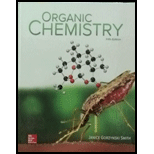
Concept explainers
(a)
Interpretation: The given compound is to be synthesized from
Concept introduction: Halogens react with
(b)
Interpretation: The given compound is to be synthesized from
Concept introduction: Halogens react with alkanes in presence of heat or light to form alkyl halides. This is known as halogenation reaction. This is a free radical substitution reaction. In this the halogen substitutes the hydrogen atom from
Dehydrohalogenation reaction is a class of reaction in which the removal of hydrogen halide takes place in the presence of strong base.
(c)
Interpretation: The given compound is to be synthesized from
Concept introduction: Halogens react with alkanes in presence of heat or light to form alkyl halides. This is known as halogenation reaction. This is a free radical substitution reaction. In this the halogen substitutes the hydrogen atom from
Dehydrohalogenation reaction is a class of reaction in which the removal of hydrogen halide takes place in the presence of strong base.
Want to see the full answer?
Check out a sample textbook solution
Chapter 15 Solutions
ORGANIC CHEMISTRY-W/ACCESS >CUSTOM<
- Dimethyl cyclopropanes can be prepared by the reaction of an α, β- unsaturated carbonyl compound X with two equivalents of a Wittig reagent Y. Draw a stepwise mechanism for this reaction.arrow_forwardDetermine the product formed when compound A is treated with each reagent.arrow_forwarda) Draw two different enol tautomers of 2-methylcyclohexanone. (b) Draw two constitutional isomers that are not tautomers, but contain a C = C and an OH group.arrow_forward
- Draw the product formed when (CH3)2CHOH is treated with each reagent (d, e and f)arrow_forwardDraw the products (including stereoisomers) formed when benzaldehyde (C6H5CHO) is treated with each Wittig reagent.arrow_forwardWhich compounds (B–F) are identical to A? (b) Which compounds (B–F) represent an isomer of A?arrow_forward
- β-D-Glucose, a hemiacetal, can be converted to a mixture of acetals on treatment with CH3OH in the presence of acid. Draw a stepwise mechanism for this reaction. Explain why two acetals are formed from a single starting material.arrow_forwardDevise a synthesis of each substituted cyclopropane. Use acetylene (HC=CH) as a starting material in part (a) and cyclohexanone as a starting material in part (b). You may use any other organic compounds and any needed reagents.arrow_forwardDraw all constitutional isomers formed when each alkene is treated with NBS + hv.arrow_forward
- (a) Draw the products formed when propane is heated with Br2. (b) Label major and minor products and explain with an energy diagram.arrow_forwarddraw the structure(s) of the major organic product(s)arrow_forward(a) Give the IUPAC name for A and B. (b) Draw the product formed when A or B is treated with each reagent: [1] NaBH4, CH3OH; [2] CH3MgBr, then H2O; [3] Ph3P = CHOCH3; [4] CH3CH2CH2NH2, mild acid; [5] HOCH2CH2CH2OH, H+.arrow_forward
 Organic ChemistryChemistryISBN:9781305580350Author:William H. Brown, Brent L. Iverson, Eric Anslyn, Christopher S. FootePublisher:Cengage Learning
Organic ChemistryChemistryISBN:9781305580350Author:William H. Brown, Brent L. Iverson, Eric Anslyn, Christopher S. FootePublisher:Cengage Learning
